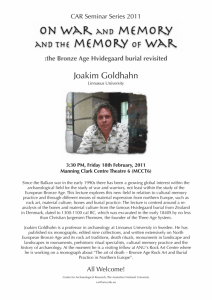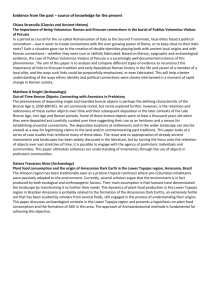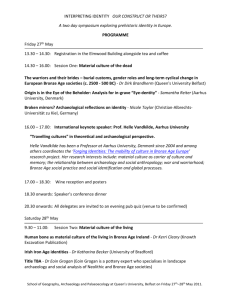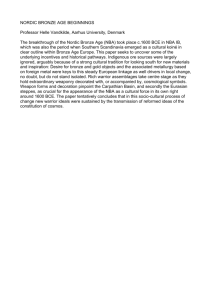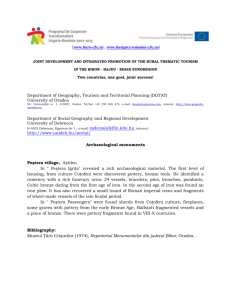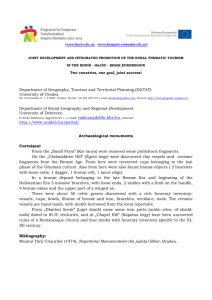The impact of 19th century ideas on the construction of 'urnfield' as a
advertisement
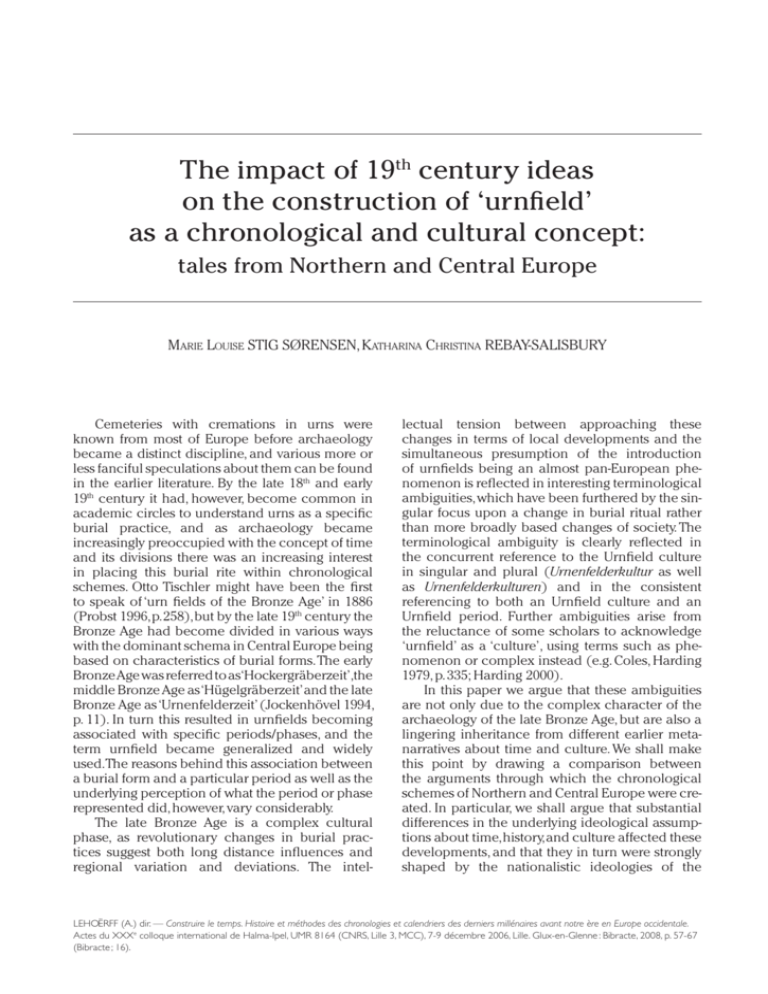
The impact of 19th century ideas on the construction of ‘urnfield’ as a chronological and cultural concept: tales from Northern and Central Europe Marie Louise Stig Sørensen, Katharina Christina Rebay-SALISBURY Cemeteries with cremations in urns were known from most of Europe before archaeology became a distinct discipline, and various more or less fanciful speculations about them can be found in the earlier literature. By the late 18th and early 19th century it had, however, become common in academic circles to understand urns as a specific burial practice, and as archaeology became increasingly preoccupied with the concept of time and its divisions there was an increasing interest in placing this burial rite within chronological schemes. Otto Tischler might have been the first to speak of ‘urn fields of the Bronze Age’ in 1886 (Probst 1996, p. 258), but by the late 19th century the Bronze Age had become divided in various ways with the dominant schema in Central Europe being based on characteristics of burial forms. The early Bronze Age was referred to as‘Hockergräberzeit’,the middle Bronze Age as ‘Hügelgräberzeit’ and the late Bronze Age as ‘Urnenfelderzeit’ (Jockenhövel 1994, p. 11). In turn this resulted in urnfields becoming associated with specific periods/phases, and the term urnfield became generalized and widely used.The reasons behind this association between a burial form and a particular period as well as the underlying perception of what the period or phase represented did, however, vary considerably. The late Bronze Age is a complex cultural phase, as revolutionary changes in burial prac‑ tices suggest both long distance influences and regional variation and deviations. The intel‑ lectual tension between approaching these changes in terms of local developments and the simulta­neous presumption of the introduction of urnfields being an almost pan-European phe‑ nomenon is reflected in interesting terminological ambiguities, which have been furthered by the sin‑ gular focus upon a change in burial ritual rather than more broadly based changes of society. The terminological ambiguity is clearly reflected in the concurrent reference to the Urnfield culture in singular and plural (Urnenfelderkultur as well as Urnenfelderkulturen) and in the consistent ­referencing to both an Urnfield culture and an Urnfield period. Further ambiguities arise from the reluctance of some scholars to acknowledge ‘urnfield’ as a ‘culture’, using terms such as phe‑ nomenon or complex instead (e.g. Coles, Harding 1979, p. 335; Harding 2000). In this paper we argue that these ambiguities are not only due to the complex character of the archaeology of the late Bronze Age, but are also a lingering inheritance from different earlier meta­ narratives about time and culture. We shall make this point by drawing a comparison between the arguments through which the chronological schemes of Northern and Central Europe were cre‑ ated. In particular, we shall argue that substantial differences in the underlying ideological assump‑ tions about time, history, and culture affected these developments, and that they in turn were strongly shaped by the nationalistic ideologies of the LEHOËRFF (A.) dir. — Construire le temps. Histoire et méthodes des chronologies et calendriers des derniers millénaires avant notre ère en Europe occidentale. Actes du XXXe colloque international de Halma-Ipel, UMR 8164 (CNRS, Lille 3, MCC), 7-9 décembre 2006, Lille. Glux-en-Glenne : Bibracte, 2008, p. 57-67 (Bibracte ; 16). Marie Louise Stig Sørensen, Katharina Christina Rebay-SALISBURY 19th century as well as the emerging concern with the demarcation of distinct scientific fields. In Northern Europe the means of establishing this association was provided by the developing ideas of typology and stratigraphy, both essen‑ tially linear and evolutionary principles, while in Central and Eastern Europe concepts of peoples (Volk) and cultural groups remained an influen‑ tial paradigm. These differences had long-term interpretative implications that still affect the study of the late Bronze Age.The label ‘urnfield’ and how it is used to refer to either a period or a culture is, therefore, a very interesting example of core con‑ cepts being ‘filled’ with a variety of meanings and understandings. The division of time – a tale from Northern Europe If we first try to trace the north European development, then Christian Jürgensen Thomsen is a suitable starting point. His Three Age System of 1836 inserted the expectation of a time perspective into the classification and ordering of objects. In principle, this meant that any object, including the urns and their various contents, could be placed within this order; they could, for example, be classified as being from the Bronze Age.Meanwhile, despite the methodological autonomy of the Three Age System, the limited explanations that were offered were directly borrowed from history and its preoccupation with people and invasion was used as the explanation for change. During the mid 19th century, Jens Jacob Asmussen Worsaae added three important dimen‑ sions to this framework. One was the observation of stratigraphy and through that a logical reasoning for the chronological relationship and the direc‑ tion of change, whereby the observation ‘over’ became equated with younger. This emphasis on physical observation clearly relates to other con‑ temporary arguments that were widely influential in Northern Europe. In Sweden, for example, Nils Bruzelius argued already in 1854 that urns belong to the later Bronze Age based on the observation that they were repeatedly found in the barrow fill over inhumation graves, and to him it was obvious and unproblematic to link the urns to a change in burial practice (Gräslund 1987, p. 40). The second important change was that Worsaae argued for archaeology as the supreme national 58 science, suggesting that the people ‘by turning its gaze inward will be able to unite the strength of the past to the wisdom of the present and through that educate itself to be independent and free’ (Worsaae 1843, p.116). In this emphasis, Worsaae effectively and very influentially equated people with the nation. In effect he made the concern with who the people were superfluous, as they became the ancestors of the present nation. The third important change was the severing of the ­previous close link to history and the realignment of the emerging profession of archaeology with the natural sciences. This was partly in an attempt to consolidate the independence of archaeology as a discipline (Worsaae 1843; 1846; 1882, p. 2), and partly a rejection of the written sources as biased and prejudiced (e.g. Worsaae 1846, p. 2 ff; 1847, p. 379 ff; see also Sørensen 1984). Worsaae also argued strongly for the use of inductive methods with hypotheses set up to be tested (as illustrated in the ‘Kitchen-midden Commission’) and com‑ parison with ethnographic examples stressed (Worsaae 1841, p. 137). Oscar Montelius represents the last stage in the creation of an explicit, detailed and in effect ­linear and evolutionary division of the past, and he continued to emphasise the similarity with natural science (e.g. Montelius 1899). His subdivision of the Bronze Age into six periods in 1885 was based on similarities and differences between objects, being used to create typological series that were equated with development (Montelius 1885). This made it possible to discuss objects in terms of progress and linear evolution. In Northern Europe by the end of the 19th cen‑ tury, time was thought of as linear and dividable, and concepts like peoples or cultures had largely become subsumed both within these divisions and within the all-embracing concept of the nation. In Northern Europe it was widely accepted that cre‑ mation in urns and the use of urnfields constituted the dominant burial practice of the late Bronze Age. This view is clearly formulated in the discus‑ sions of Danish prehistory by influential scholars such as Sophus Müller (1897) or Oscar Montelius (1885; 1903, p. 15). Discussions like these were, how‑ ever, not unique to Northern Europe, and most had counterparts in Central and Eastern Europe,but the discussions there resulted in other understandings, and it is these that influenced the ways in which the late Bronze Age came to be understood there. The impact of 19th century ideas on the construction of ‘urnfield’ as a chronological and cultural concept Scepticism about the Three Age system – a tale from Central Europe In southern Germany and Austria, the Three Age System was not yet fully accepted by the late 19th century, and there was a degree of uncertainty about the date of archaeological finds and their contexts. It has been argued that this was because the archaeology was more complex than in the north (Sklenář 1983, p. 88). The data did not, for example, suggest a ‘pure Bronze Age’ in the same way as it did for northern Germany and Denmark. Many of the big cemetery sites contained finds of both bronze and iron, without the suggestion of an obvious preference for one of the materials,­causing intense debate about whether they belonged to the Bronze or the Iron Age. Other reasons for the scepticism were technological concerns. The belief that holes in stone tools could only be made with metal tools and decorations on bronze arte‑ facts could only be imprinted with steel tools was widespread (Sklenář 1983, p. 118). Subdivisions of the Bronze Age were delayed and followed a more fragmentary progress than in Northern Europe. To understand this reluctance towards adapting the proposed chronologies it is important to recognise how specific aspects of the interpretative paradigms and the composition of the archaeological evidence conspired against the proposed framework.For example,changes in burial forms had for a long time been strongly linked to the assumption of a change of population, and in turn it was not conceivable that single cemeteries could belong to several ages or periods.Rather than seeing cemeteries as the result of successive time phases, they were assumed to represent coherent social or cultural entities. This meant that the many attempts to develop finer chronologies were all based on individual cemeteries (e.g. Hallstatt, Stillfried, Ruše, Ljubljana; Teržan 1990, p. 21-25), rather than aiming at the construction of general chronological systems applicable to whole regions and many cemeteries.The resulting understanding of chronological sequences as a sequence of culture names is reflected by the numerous and various chronologies of Central, Eastern and Southern Europe (Harding 2000, 14-18). The point of such debates is exemplified by the responses to Georg Wurmbrand’s presenta‑ tion of the cemetery ‘Maria Rast’ in Slovenia to the 8th International Congress for Anthropology and Prehistoric Archaeology in Budapest in 1876 (Wurmbrand 1876, p. 29). Three of the graves in this cemetery were clearly Roman, so the exca‑ vators wanted to interpret the entire cemetery as ‘celtic-germanic’ and as ending with the Roman occupation (Wurmbrand 1876, p. 31). During the congress it was argued that not all of the burials of a cemetery necessarily had to belong to one period of time, suggesting that until then it had been commonly assumed that a cemetery had to belong to only one period. It is therefore ­interesting to note that Wurmbrand’s view was challenged by scholars from Northern Europe such as Ingvald Undset and Johanna Mestorf (Undset 1882). From this dispute, we learn that a cemetery was com‑ monly seen to represent a group of people rather than being a place used over several periods. The cemetery of Hallstatt played a significant role in this discussion of later European chronology. The first finds were collected in the 18th century, but systematic excavations by Johann Ramsauer started in 1846 under the patronage of Eduard Freiherr von Sacken. Ramsauer excavated about 980 graves, both inhumations and cremations. Isidor Engel’s exceptional documentation, water coloured paintings, and the sheer amount of finds made Hallstatt well known beyond the boundaries of the country. Von Sacken’s quite detailed cemetery publication of 1868, however, struggled with the dating of the finds. He pointed out that the mixture of Bronze and Iron finds was characteristic,‘which caused a lot of astonishment among Danish scholars’ (Sacken 1868, p. 129). He rejected classification on the basis of materials, instead, his classification was based on ­comparing styles. After Hans Hildebrand had suggested sub‑ dividing the Iron Age and naming the phases after Hallstatt and La Tène in 1874 at a congress in Stockholm (Weiss 1999, p. 9), Otto Tischler sug‑ gested the ‘structuring of pre-roman Iron Age of southern Germany’ at a congress in Regensburg in 1881. By that time, the lack of finds from a ‘pure Bronze Age’ had been filled with evidence from the alpine lakesides, the cemetery of Unĕtice had been discovered, and the similarities between the southern German and Austrian finds with Etruscan cemeteries such as Villanova, Benacci, Aronaldi and Certosa had been recognized. Tischler’s sug‑ gestion was to divide the Hallstatt Period into an earlier and later phase on the basis of the finds from the cemetery of Hallstatt. Covering a time span from 1000 to 400 BC, the Iron Age still also subsumed the urnfield period (Tischler 1881, p. 124, 127). 59 Marie Louise Stig Sørensen, Katharina Christina Rebay-SALISBURY Ingvald Undset, who had then just published a book on the beginnings of the Iron Age in Northern Europe, commented on Tischler’s talk and stated that while in Northern Europe this period had to be characterized as Bronze Age, further south, a full Iron Age had already developed. He also mentioned that several groups of vast urnfields in Northern Germany fell exactly in this transitional period between the Bronze and the Iron Age and thus characterised an era. He himself, however, states that the term ‘urnfield’ alone does neither imply a chronological nor an ethnic entity (Undset 1882, p. 132). The next significant step was the work of Paul Reinecke, who during the end of the 19th and beginning of the 20th century contributed significantly to the refinement of the chronology. Reinecke first established a detailed Bronze Age chronology for Hungary in 1899 (Reinecke 1899). In order to link this material with the German material, the cemetery of Hallstatt again played a crucial role. In 1900, Reinecke published his first suggestion for a ­phasing based mainly on weapon forms. He clearly stated that he understood the Hallstatt period to be a transitional phase between the Bronze- and Iron Age (Reinecke 1900, p. 44), rejecting the idea that differences in burial customs such as burial mounds and flat cemeteries reflect ethnicity (Reinecke 1900, p. 45). In 1902, the chronological system for southern Germany that still underpins Central European chronological schemes followed (Reinecke 1902). Reinecke combined the typological method with the dating of single contexts through finds combination. In the course of his career, he established a system of the Bronze Age, Hallstatt and La Tène Period with four subdivisions each, thus introducing the Bronze Age A-D and Hallstatt A-D terminology (Reinecke 1904-1911, reprint 1965). Reinecke’s chronology was a departure from previous schemes in two important ways. First, it could be applied to large regions and all types of contexts rather than only being relevant to individual cemeteries. Secondly, in its singular dependency upon finds typologies and combinations it severed the link to broader concepts of culture and people. It is through their shared focus upon object typology that the Montelian and the Reinecke system gave rise to similar kinds of abstract chronological systems detached from concepts of culture or society.There are also, however, interesting differences between the two schemes. With regard to the Late Bronze 60 Age specifically, it is therefore important to note that in Reinecke’s system Hallstatt refers to both the Late Bronze Age (Ha A-B) and the early Iron Age (Ha C-D).This is an important difference from Montelius’schema in which the Bronze Age (Period I-VI) remains separated from the Iron Age. In effect, one may see Reinecke’s system as blurring the distinction between the Bronze and the Iron Age and giving primacy to the subdivisions while the Montelian system maintains and gives importance to the division between the two ages. Reinecke initially used ‘Bronzezeit D’ to repre‑ sent the end of the Tumulus culture as a period with some infiltration of urnfield elements. This was based on observations such as the Riegseegroup, where barrows were still present after the introduction of cremation (Smith 1957, p. 206). The significant break Reinecke saw between Bronzezeit D and Hallstatt A appeared not as sharp to later scholars (Müller-Karpe 1959, p. 151), and Georg Kraft suggested already in 1926 that Ha A and B should be replaced with Bronzezeit E and F (Kraft 1926), although this was of course never generally accepted. The further discussions of the Central European chronologies took place within the Reinecke system. Hermann Müller-Karpe fur‑ ther refined the typology of Bronze finds and created a six division scheme for the Urnenfelderzeit in 1959 (Müller-Karpe 1959). Finer and more regional divisions on the basis of seriation and 14C dates were suggested by Lothar Sperber in 1987 (Sperber 1987). Through these works the distinc‑ tion between Hallstattkultur (culture), meaning Hallstatt C and D, and Hallstattzeit (age), meaning Reinecke’s Hallstatt A-D, was gradually abandoned, and this cleared the path for perceiving the Late Bronze Age as a prehistoric era in its own right. Concepts of nations, peoples and cultures Underlying the discussion and development of chronologies there was also a consistent debate about what or who the material represented or related to, and these were important influential factors behind the divergence between Northern and Central Europe. By the late 18th century it had already become common to assume links between the urnfields and groups of people. Some of this was influenced by various types of historical sources that appeared to provide the names of earlier peoples. The influence of such sources The impact of 19th century ideas on the construction of ‘urnfield’ as a chronological and cultural concept is illustrated, for example, by Georg Lisch, who in 1837 used the material from Mecklenburg to propose a basic ethnic classification of burial types. He used Hühnengräber to refer to what he called ‘old Germanic’, Kegelgräber was used to refer to the burials mounds of Germanic tribes contemporary with Tacitus, and Kirchhöfe were ascribed to the Slavs (Lisch 1837, p. 18, 23, 26, after Gummel 1938, p. 127). The term Kirchhof’ used to refer to cremation burial of Slavic origin, but was rejected in the 1850s, because it implied Christianity, and the more ‘neutral’ term Friedhof was suggested (Gummel 1938, p. 153). In Germany the more general labelling of prehistoric graves as ‘germanisch’ was widespread during the 19th century,and is often used in the protocols of various local historical societies (e.g. Dobiat 1994, p. 14). For Central Europe, ethnic classifications ranged from Celtic to Germanic and Slav (Sklenář 1983, p. 91-101). In addition, Central European prehistory continued to be overshadowed by Roman remains and literary sources. Although the enthusiasm for the Romans was soon countered with an enthusiasm for Germans (Gramsch 2006, p. 5), the roman occupation provided a starting point for the classification of archaeological material according to ethnic names known from history. For example, the first rough dating of the cemetery of Hallstatt in 1848 as pre-roman ‘celtic’ was based on the arguments that there were not enough weapons to classify it as Germanic, and that the lack of coins contradicted the classifica‑ tion as Roman. Cleverly, Johann Gaisberger also excluded contemporaneity with the Romans, since no roman trade goods were found on the cemetery (Gaisberger 1848). As grave forms were associated with specific peoples, cemeteries like Hallstatt with both cremations and inhumations caused astonishment. A solution put forward by Eduard von Sacken in 1868 was to ascribe the cemetery to a mixed population of Etruscans and Celts (Sacken 1868, p. 146). On this background, Reinecke’s work is even more remarkable as it was neither concerned with the identification of peoples nor with time in an evolutionary sense. His work moved the focus away from cultural history, and rather aimed at the classification and order of the archaeologi‑ cal material. This is reflected at many levels of his work including the manner in which he used the terminology as systematising and descrip‑ tive terms rather than interpretative ones. His use of the word ‘Urnenfelder’ refers to a particular ­ urial practice, and not to a culture or group. In b his essay on the end of the pure Bronze Age (Ende der reinen Bronzezeit), for instance, he refers to typical tumuli burials and contrasts them with other burial forms that consist of flat graves with cremation – and he uses the word ‘Urnenfelder’ as a descriptive term only (Reinecke 1965 [1906], p. 11). Similarly, in another essay from this period, in which he argues that Ha A should be classified as belonging to the early Iron Age, he uses the words Urnenfriedhöfe and Urnenfelder as interchan­geable terms (Reinecke 1965 [1906], p. 26-27). Reinecke’s abstract system was not, however, an explicit rejection of traditional interpretations. It is therefore important to recognise that it left unchallenged residual ideas about peoples, making it possible for such thinking to resurface in later debates. Therefore, while Reinecke’s chrono­logical system remained in use, his lack of interest in associating the objects with peoples remained an exception rather than the norm in Central Europe during the late 19th and early 20th century. From the 1890s onwards, a growing interest in identifying ‘the people’ behind the change in burial practice re-emerged, and there was resurgence in inter­pre­ta­ tions which favoured terms such as Urnfield-culture, rather than Urnfield period or phase. This development was influenced by an ever‑ more explicit interest in the archaeology of the nation state, fuelled by the general politics at the time (e.g.Champion and Diaz-Andreu 1996; Sklenář 1983, p. 134). In contrast to Northern Europe, how‑ ever, where the concept of the nation was based on an unquestioned sense of unifor­mity and long his‑ tory, the question of which people constituted the nation was far more complex in Central Europe. As a general approach, however, differences in material culture were explained by reference to different peoples, with more modest variation explained by reference to tribes. Two theoreti‑ cal approaches became particularly important in shaping these ways of thinking about the ‘urn‑ field culture’, namely the Kulturkreislehre and the Siedlungsarchäologische Methode. Intellectual approaches at the turn of the century: Kulturkreislehre and Siedlungsarchäologische Methode The significance of the intellectual approaches that developed in Central Europe during the late 19th century and early 20th century must be under‑ 61 Marie Louise Stig Sørensen, Katharina Christina Rebay-SALISBURY stood in the context of the close ties between physical anthropology, ethnography, and prehistory at the time in many parts of Europe. In Central and Western Europe, roman monuments were omni‑ present and significant importance was granted to historical sources such as classical texts. In its struggle for recognition, prehistory could only benefit from close alignment with anthropology and moved towards a new interpretative paradigm within ‘natural history’, while still retaining strong contacts to history. The concept of the Kulturkreislehre (science of cultural circles) was introduced into ethnology by Leo Frobenius in 1898, modified by Fritz Gräbner (Gräbner 1911) and in use around the turn of the 20th century in Central Europe.The Viennese ethno‑ logical school, with the catholic clergyman Walter Schmidt as its main representative (Kossack 1992, p. 85),was particularly influential; ideas were picked up explicitly by scholars such as Oswald Menghin (Kossack 1992, p. 85), but implemented in a more subtle way by many others (Veit 1989, p. 41). The root of the approach was the desire to integrate various ethnographic cultures into general historical development.The methods of the Kulturkreislehre were to compare similar culture elements in order to trace the centre of origin of a particular combination of elements. The resulting cultural circles were then placed in chronological order.The Kulturkreislehre aimed to write a ‘history of civilisation’, covering all cultural expressions of all peoples, regardless of time and space (Gräbner 1911, V). It is based on an approach in which ethnology is essentially historical and ‘cultural elements rest solely on an historical connection’ (Kluckhohn 1936).This historical focus meant that Kulturkreislehre differentiates between the origin of cultures, developing the concepts of the ‘primary’ and ‘secondary’ cultures, and thus assigns different values to different cultures. The Kulturvölker (civilised people) stand above the Naturvölker (primitive people), whose development had simply stopped at some point. The stage of their development can be determined by ethnographic as well as archaeological research. It was assumed that similar forms of material culture in different geographical areas must have had a common source; hence cultural change is seen as a result of diffusion rather than evolution (Sklenář 1983, p. 146). In its application the Kulturkreislehre is generally descriptive rather than explanatory, great effort was put into describing the detailed 62 components of each Kulturkreis as well as defining their boundaries. The reasons and mechanisms of change are given rather than being subject to analysis, and the research became focused on tracing back the origins of particular forms of material culture. Cultural change is seen as a groupspecific process rather than a general trend in an evolutionary development (Kossack 1992, p. 86). The integration of these ideas into archaeology is exemplified by Jacob-Friesen’s definition of the practice of prehistory as ‘defining as many individual distribution areas of given forms as possible, gathering those together into Kulturkreise and establishing their chronological succession’ (Jacob-Friesen 1928, 145; after Veit 1989, p. 41). The use of the word Kulturkreis on its own does not, however, always integrate all that is implied by this theoretical paradigm. In post war Germany, the term is sometimes merely used to refer to the distribution area of artefacts, and the uncertainty of its implication of peoples was met with attempts to redefine it (e.g. Bergmann 1974, p. 129-138). One of the implications of adopting this intel‑ lectual framework was the division of the Hallstatt culture in a Westhallstattkreis and Osthallstattkreis (Müller-Scheeßel 2000). Furthermore, through the method of back-projection, chronologically later cultural entities, such as the Hallstattkreise, were used to reconstruct earlier entities, such as the Urnenfelderkreise. In addition, the approach had interpretative implications due to its strong emphasis upon centre of origin, casting some areas as the receiving partners and others as the higher cultures. In this view, often coined as lux ex oriente, the Central European Bronze Age cul‑ tures were, for instance, considered Randkulturen, less advanced and innovative compared to the higher civilisations of the Mediterranean cultures (Sklenář 1983, p. 144). The second influential framework of thinking around the turn of the centuries, and in many ways overlapping with the Kulturkreislehre (Bernbeck 1997, p. 27), was rooted in history rather than ethnography. Gustaf Kossinna developed his Siedlungsarchäologische Methode based on the idea that ‘sharply defined archaeological culture areas correspond at all times to the areas of particular peoples or tribes’ (Kossinna 1911, p. 3, translation in Härke 2000, p. 44). He used the earliest historically documented peoples as a starting point and linked the archaeological record to named peoples, and from there he moved back in time – even attempting to trace named peoples The impact of 19th century ideas on the construction of ‘urnfield’ as a chronological and cultural concept as far back as the Mesolithic (Kossinna 1911, p. 29). Like many of his contemporaries, Gustaf Kossinna saw archaeology as a means of writing the history of the peoples – and in his case the Germans (Gummel 1938, p. 316-371; Veit 2000, p. 40-42). His 1911 paper in the journal Mannus titled ‘Die Herkunft der Germanen’ (The origin of the Germans) makes this approach clear (Kossinna 1911). Intentionally or not, Stephen Oppenheimer’s recent book on the genes of British people uses exactly the same phrasing – ‘The Origins of the British’ (Oppenheimer 2006). Regarding the Bronze Age, it is interesting to notice how certain political desires affected the interpretations. For instance, Kossinna consistently assigned the Nordic Bronze Age to the Germanic people, while he found it more difficult to decide about both the South-German and the Lusatian Urnfield Cultures. Through time his interpretation of these groups refers to various historically named peoples, such as the Ancient Germanic, Slavic, Illyric, Kapodacian and Celtic. It is ­fascinating to note how such arguments were formulated, as illustrated by Kossinna’s changing interpretation of the urnfields in the area of Northern Eastern Europe. The actual political concern behind this discussion was to name the peoples along the German/Polish border. This group of urnfields was recognised and labelled Lausitz in 1874 by Rudolf Virchow (Virchow after Gummel 1938, p. 259). Kossinna saw this group as ‘ungermanisch’, but was at the same time reluctant to accept them as Slavs (Kossinna 1911, p. 21). Another interesting facet to the Central European debate is that Kossinna was strongly against seeing Central European prehistory as inferior to the cultures of the Mediterranean, and he argued for an independent development. His feelings about the question of Mediterranean ­influences are illustrated by the durable enmity towards Carl Schuchhardt. Kossina criticised Schuchardt’s interest in the archaeology of the remains of the ancient Roman provinces as unnational and ridiculed him as ‘Römling’, as dem Orientfehler verfallen (Sklenář 1983,p. 149; Schwerin von Krosigk 1982). Kossinna also tried to ascribe virtues such as ‘being the bearer of progress and the creators of all great values’ to the Germanic peoples (Penka 1907 after Sklenář 1983, p. 149). The obvious potentials for political manipulation of the past arising from these arguments have recently become exten‑ sively discussed (e.g. Härke 2000,Veit 1984,Werbart 1996). In this use of language and associations we find much similarity with Worsaae, but where Worsaae’s nation is ubiquitous and the nation and people one, for Kossinna the singular focus is the people. In the changing political landscape of Central Europe, the referencing to the nation was, although recognized as important, much more of a challenge. Some of Kossinna’s contemporaries, while agreeing with the underlying concepts, disagreed with his interpretations. Many continued to argue that the sources of the cultural impulses and the movement of people had to be sought in the Near East and the Mediterranean. The search for origins of specific traits of material culture through cultural contacts was one of the occupations of the Marburger School founded by Gero von Merhart. The other special interest was detailed investigation of material culture and the continuing work on regional chronological schemes, work that took place within the Reinecke system (Theune 2001, p. 158). Merhart used ethnic interpretations very carefully. One of his main aims was to find the origin of objects through detailed comparison between the single features on individual objects. In his opinion, the origins of the Urnfield culture were to be found in the Danube and Balkan region, and he argued that several waves of migrations had caused the distribution of certain types of objects, such as ornaments, weapons and sheet armour further south and east of their area of origin and reaching as far as the Aegean (Schauer 1975, p. 121). The Marburger school gained tremendous influence after the Second World War, since every trait of research that could vaguely be associated with nationalism was rejected in Germany and Austria and the focus of research went back to detailed investigation of material culture (known as the Kossinna-Syndrom, Smolla 1980); Merhart’s approach was very suitable to this agenda. Many of Merhart’s pupils, such as Hermann MüllerKarpe, Georg Kossack, Werner Coblenz, Wolfgang Dehn, Friedrich Holste, Hans-Jürgen Hundt and Wolfgang Kimmig, became successful and influential scholars on the Bronze and Iron Ages, working in universities all over Germany. The controversy about whether the Urnfield culture was an expression of indigenous development or a result of Mediterranean impact continued. The argument for a Central European origin of the ‘Urnfield culture’ was later changed into a range of different interpretations of the relationship 63 Marie Louise Stig Sørensen, Katharina Christina Rebay-SALISBURY between Central Europe and the Mediterranean. Among others, Hermann Müller-Karpe argued for mutual, complex relationships and contacts between the areas, which cannot be understood in terms of migrations and people’s movements (Müller-Karpe 1962, p. 280-284). In contrast, Wolfgang Kimmig combined the archaeological record and historical sources in his 1964 article Seevölkerbewegung und Urnenfelderkultur to construct an argument for the Late Bronze Age as a period of migration and warfare. He sees the disruptions in the Eastern Mediterranean by the so-called Sea people connected with the spread of the Urnfield culture (Kimmig 1964). He also discusses the possibility of identifying the peoples represented by the archaeological record of the Urnfield culture (Kimmig 1964, p. 268-273), by pointing out the connections between the prehistoric people in Europe and the people of the Mediterranean known through written history. Although it is politically correct in post-war Germany to understand archaeological cultures as no more than a term for an entity which is spatially and chronologically distinguishable within the general cultural development, it is clear from the above that the underlying concepts of peoples and tribes have not died out (see also Veit 1989, p. 50; Kossack 1995, p. 3). A view from a different angle: Childe’s view on the Late Bronze Age One of Vere Gordon Childe’s main research interests was the relationships between European and Near Eastern developments. He integrated Central and Eastern European archaeology in his work, added his own frameworks of thinking and he shaped the perception of English speaking research on the Late Bronze Age of Central Europe. In contrast to Reinecke, who argued for gradual cultural development, Childe’s conception of his­ tory was dominated by radical changes,revolutions and wars (Blischke 2002, p. 25), and this affected his concept of ‘Urnfield’. Childe was informed by diametrically opposed political ideas to those of Kossinna, and the two are consistently associated with contrasting uses of the past. It is therefore noteworthy that there are substantial overlaps in their definition of ­culture. For both scholars, peoples played the leading role in cultural development, be it Germanic or Mediterranean peoples.Childe is therefore in many ways one of the most direct pupils of Kossinna 64 (see also Veit 1989, p. 39), although he stripped the interpretations of their specific ideological baggage. Childe defined culture as the regularly found association of types of artefacts as well as domestic and funerary structures over a given area (Childe 1930, p. 41-42) and stated further that ‘In a culture thus defined there is a good reason to recognize the material expression of that com‑ munity of traditions which distinguishes a people in the modern sense’ (Childe 1930, p. 42). From this assumption he deduced that culture, i.e. peoples and their cultural practices, can move about, and migrations can therefore be detected through the archaeological record when we see the spread of the whole complex of types, habits and fashions rather than just single types. He argued that change in pottery and burial rites, ‘the more intimate and imponderable traits of a culture’ (Childe 1930, p. 42), are particularly strong indicators of migra‑ tion as he believed such aspects were unlikely to be the result of trade or imitation. While Childe’s definition of culture and his view on the underlying forces of change may have been relatively consistent throughout his academic work, his interpretation of the origin of the Urnfield culture seems to change through time. Childe argued strongly for the movement of people and the importance of cultural influences as the core mechanisms of cultural change during the late Bronze Age. His focus on the Danubian cultures brought new areas into the debate. He discussed the Hungarian, Lausitz-Type and North Alpine Urnfield cultures in great detail. As for the origin of the Urnfield folk, he listed three possibilities: ‘It remains possible that the Urnfield folk were (I) descendants of the local Aunjetitz-Straubing population of the lowlands, or (II) invaders (a) from the Lausitz area or (b) from the south-east, or were (III) constituted from a combination of these elements’ (Childe 1929, p. 349). In ‘The Bronze Age’, Childe pointed out that despite its strong Oriental flavour, the late Bronze Age civilisation was industrially based on Central Europe (Childe 1930, p. 194). He described the late Bronze Age as ‘…an epoch of turmoil and migra‑ tion though it witnessed immense industrial and economic progress, forced upon the barbarians by these times of stress’ (Childe 1930, p. 192). In the concluding chapter titled ‘races’, Childe proposes continuity both in ‘blood and tradition’ between the Bronze Age and modern population (Childe 1930, p. 240), and linking language and culture, he stated that it should be possible to connect the The impact of 19th century ideas on the construction of ‘urnfield’ as a chronological and cultural concept several Bronze Age cultures with branches of the Indo-European linguistic family, such as Teutons, Kelts, Italici, Hellenes, Illyrians, Thraco-Phrygians and Slavs (1930, p. 234-247). In ‘Prehistoric Migrations’ he seems to have changed his views about the origin of the change in burial practice that took place during the Urnfield period. Despite acknowledging earlier sporadic occurrences of cremation,he argues in this volume that Troy VI (dated then to the 14th century) was the model for the development of cremation in Central Europe. This in turn led him to conclude that cremation was introduced from Greece, not by a mass migration but by missionaries, chieftains or a conquering aristocracy (Childe 1950, p. 209). In his approach to prehistory as successive technological stages with parallel social develop‑ ment rather than ages (Childe 1944, p. 7), Childe saw the late Bronze Age as a ‘critical period’, a period of crisis, both in the Near East and Central Europe (Childe 1944, p. 177). Regular Bronze Age economy was established and metal had become cheap and used regularly even for tools. He saw the ‘expansion of Urnfield people’ as triggered by a successful economy and population growth that led to ‘following or mixing with Tumulusbuilders’ (Childe 1944, p. 215). With regard to Northern Europe, Childe assumed that the Nordic Bronze Age (Montelius period II and III) should be equated with the late Bronze Age of Central Europe (Reinecke Bz D, Ha A and B). Childe inter‑ preted the spread of cremation as an ideological movement (Childe 1944, p. 183) and argued that it was possible that ‘urnfield chieftains did reach the Baltic’ and that they influenced the Nordic Bronze Age until urnfields became the normal rite (Childe 1950, p. 203-204). Instead of a conclusion: moving towards a new interpretative paradigm While the construction of the concept of a late Bronze Age/Urnfield culture in Northern and Central Europe appears to draw upon similar con‑ temporary influences, variations within the local conditions meant that subtle but fundamental dif‑ ferences developed. It is commonly recognised that the contemporary political ideologies were influential in shaping academic debates. In this paper, we have tried to show the variations in the discussion of one topic contrasting Northern and Central Europe. This should be understood as a starting point; to fully understand the concept of the ‘Urnfield culture’, much more research will be required. In contrast to the 19th century development in Northern Europe, the methods that domi‑ nated the discussion of the late Bronze Age in Central Europe did not ‘liberate’ the archaeologi‑ cal interpretations from other interpretations of culture, such as those provided by history and ­ethnology. As a consequence, it became difficult to disconnect the terminology from interpretative expectations, and questions about time were rou‑ tinely framed in such a manner that the answers were about relationships between peoples and between areas. BIBLIOGRAPHY Bergmann 1974 : BERGMANN (J.). — Zum Begriff des Kulturkreises in der Urgeschichtswissenschaft. Prähistorische Zeitschrift, 49, 1974, p. 129-138. Bernbeck 1997 : BERNBECK (R.). — Theorien in der Archäologie. Tübingen: Francke, 1997. Blischke 2002 : BLISCHKE (J.). — Gräberfelder als Spiegel der historischen Entwicklung während der mittleren Bronzezeit im mittleren Donaugebiet. Universitätsforschungen zur prähistorischen Archäologie 80. Bonn, 2002. Childe 1944 : CHILDE (V. G.). — Archaeological Ages as Technological Stages. Journal of the Royal Anthropological Institute of Great Britain and Ireland, 77, 1944, p. 7–24. Childe 1950 : CHILDE (V. G.). — Prehistoric Migrations in Europe. Oslo, 1950. Coles, Harding 1979 : COLES (J. M.), HARDING (A. F.). — The Bronze Age in Europe: An Introduction to the Prehistory of Europe c. 2000-2700 BC. London: Methuen, 1979. Childe 1929 : CHILDE (V. G.). — The Danube in Prehistory. Oxford, 1929. Diaz-Andreu, Champion 1996 : DIAZ-ANDREU (M.), CHAMPION (T.C.) dir. — Nationalism and archaeology in Europe. London: UCL Press, 1996. Childe 1930 : CHILDE (V. G.). — The Bronze Age. Cambridge, 1930. Dobiat 1994 : DOBIAT (C.). — Forschungen zu Grabhügelgruppen der Urnenfelderzeit im Marburger 65 Marie Louise Stig Sørensen, Katharina Christina Rebay-SALISBURY Raum. Marburger Studien zur Vor- und Frühgeschichte 17, 1994. Gaisberger 1848 : GAISBERGER (J.). — Gräber bei Hallstadt im oberösterreichischen Salzkammergut. Linz: Wimmer, 1848. Gräbner 1911 : GRÄBNER (F.). — Die Methode der Ethnologie. Heidelberg: Winter, 1911. Gramsch 2006: GRAMSCH (A.). — Eine kurze Geschichte des archäologischen Denkens in Deutschland, Leipziger Online-Beiträge zur Ur- und Frühgeschichtlichen Archäologie, 19, 2006, p. 1-18. Gräslund 1987 : GRÄSLUND (B.). — The Birth of Prehistoric Chronology. Cambridge: University Press, 1987. Gummel 1938 : GUMMEL (H.). — Forschungsgeschichte in Deutschland. Berlin: Walter de Gruyter, 1938. Harding 2000 : HARDING (A. F.). — European Societies in the Bronze Age. Cambridge: Cambridge University press, 2000. afseende paa Skandinavien. Kongl. Vitterhets Historie och Antiqvitets Akademiens Handlingaer, 30/10. Stockholm, 1885. Montelius 1889 : MONTELIUS (O.). — Typologien eller utvecklingsläran tillämpad paa det menskeliga arbetet. Svenska Fornminnesföreningens Tidskrift, 10, 1889, p. 237268. Montelius 1903 : MONTELIUS (O.). — Die typologische Methode. Die älteren Kulturperioden im Orient und in Europa 1. Stockholm, 1903. Müller 1897 : MÜLLER (S.). — Vor Oltid. København, 1897. Müller-Karpe 1959 : MÜLLER-KARPE (H.). — Beiträge zur Chronologie der Urnenfelderzeit nördlich und südlich der Alpen. Römisch-Germanische Forschungen 22. Berlin, 1959. Müller-Karpe 1962 : MÜLLER-KARPE (H.). — Zur spätbronzezeitlichen Bewaffnung in Mitteleuropa und Griechenland. Germania, 40, 1962, p. 255-284. Härke 2000 : HÄRKE (H.) dir. — Archaeology, Ideology and Society. The German Experience. Gesellschaften und Staaten im Epochenwandel 7, Frankfurt: Europäischer Verlag der Wissenschaften, 2000. Müller-Karpe 1974 : MÜLLER-KARPE (H.). — Zur Definition und Benennung chronologischer Stufen der Kupferzeit, Bronzezeit und älteren Eisenzeit. Jahresbericht des Instituts für Vorgeschichte der Universität Frankfurt am Main, 1974, p. 7-18. Jockenhövel 1994 : JOCKENHÖVEL (A.). — Raum und Zeit – Gliederung der Bronzezeit. In: JOCKENHÖVEL (A.), KUBACH (W.) dir. — Bronzezeit in Deutschland. Sonderheft der Zeitschrift Archäologie in Deutschland. Stuttgart, 1994, p. 11-14. Müller-Scheeßel 2000 : MÜLLER-SCHEESSEL (N.). — Die Hallstattkultur und ihre räumliche Differenzierung. Der West- und Osthallstattkreis aus forschungsgeschichtlichmethodologischer Sicht. Tübinger Texte 3. Rahden/ Westfahlen, 2000. Kimmig 1964 : KIMMIG (W.). — Seevölkerbewegung und Urnenfelderkultur. In: USLAR (R. von), NARR (K. J.) dir. — Studien aus Alt-Europa 1, 1964, p. 220-283. Oppenheimer 2006 : OPPENHEIMER (S.). — The Origins of the British: A Genetic Detective Story. London: Constable and Robinson, 2006. Kluckhohn 1936 : KLUCKHOHN (C.). — Some reflections on the method and theory of the Kulturkreislehre. American Anthropologist, 38/2, 1936, p. 157-196. Probst 1996 : PROBST (E.). — Deutschland in der Bronzezeit. Bauern, Bronzegiesser und Burgherren zwischen Nordsee und Alpen. München: C. Bertelsmann, 1996. Kossack 1992 : KOSSACK (G.). — Prehistoric Archaeology in Germany: Its History and Current Situation. Norwegian Archaeological Review, 25/2, 1929, p. 73-109. Kossack 1995 : KOSSACK (G.). — Mitteleuropa zwischen dem 13. und 8. Jahrhundert v. Chr. Geb. Geschichte, Stand und Probleme der Urnenfelderforschung. In: ERBACH (M.) et al. – Beiträge zur Urnenfelderzeit nördlich und südlich der Alpen. Ergebnisse eines Kolloquiums. Monographien RGZM 35. Bonn, 1995, p. 1-64. Kossinna 1911 : KOSSINNA (G.). — Die Herkunft der Germanen. Zur Methode der Siedlungsarchäologie. Mannus-Bibliothek 6. Würzburg, 1911. Kraft 1926 : KRAFT (G.). — Die Kultur der Bronzezeit in Süddeutschland. Augsburg, 1926. Montelius 1885 : MONTELIUS (O.). — Om tidsbestämning inom bronsaaldern med särskildt 66 Reinecke 1900 : REINECKE (P.). — Brandgräber vom Beginn der Hallstattzeit aus den östlichen Alpenländern und die Chronologie des Grabfeldes von Hallstatt. Mitteilungen der Anthropologischen Gesellschaft Wien, 30, 1900, p. 44-52. Reinecke 1965 : REINECKE (P.). — Mainzer Aufsätze zur Chronologie der Bronze- und Eisenzeit. Bonn, 1965. Reinecke 1899 : REINECKE (P.). — Studien zur Chronologie des ungarländischen Bronzealters. I. Teil. Prähistorisches aus Ungarn und den Nachbarländern. Beiblatt der Ethnologischen Mitteilungen aus Ungarn, 1/1, 1899, 1 ff. Reinecke 1902 : REINECKE (P.). — Zur Chronologie der 2. Hälfte des Bronzealters in Süd- und Norddeutschland. Korrespondenzblatt der deutschen Gesellschaft für Anthropologie, Ethnologie und Urgeschichte, 33/3, 1902, p. 17-32. The impact of 19th century ideas on the construction of ‘urnfield’ as a chronological and cultural concept Sacken 1868 : SACKEN (E. von). — Das Grabfeld von Hallstatt in Oberösterreich und dessen Alterthümer. Wien, 1868. Undset 1882 : UNDSET (I.). — Das erste Auftreten des Eisens in Nordeuropa (translated by J. Mestorf). Hamburg: Meissner, 1882. Schauer 1995 : SCHAUER (P.). — Forschungen zur Geschichte der Bronzezeit in Deutschland. In: Ausgrabungen in Deutschland gefördert von der deutschen Forschungsgemeinschaft 1950-75, Teil 1: Vorgeschichte Römerzeit. Monographien RGZM, 1/1, 1995, p. 121-124. Veit 1984 : VEIT (U.). — Gustaf Kossinna und V. Gordon Childe. Ansätze zu einer theoretischen Grundlegung der Vorgeschichte. Saeculum; 35, 1984, p. 326-364. Veit 1989 : VEIT (U.). — Ethnic concepts in German prehistory: a case study on the relationship between cultural identity and archaeological objectivity. In: SHENNAN (S.) dir. — Archaeological Approaches to Cultural Identity. London: Uniwin Hyman, 1989, p. 35-56. Schwerin von Krosigk 1982 : SCHWERIN von KROSIGK (H.). — Gustaf Kossinna. Der Nachlaß – Versuch einer Analyse. Neumünster, 1982. Sklenář 1983 : SKLENÁŘ (K.). — Archaeology in Central Europe: the First 500 Years. New York: Leicester University Press, 1983. Weiss 1999 : WEISS (R.-M.). — Die Hallstattzeit in Europa. In: MENGHIN (W.) dir. – Hallstattzeit. Die Altertümer im Museum für Vor- und Frühgeschichte Berlin 2. Mainz, 1999, p. 7-22. Smith 1957 : SMITH (M. A.). — A study in Urnfield Interpretations in Middle Europe, Zephyrus, 8/13, 1957, p. 195-235. Werbart 1996 : WERBART (B.). — All these fantasic cultures? Concepts of archaeological cultures, identity and ethnicity. Archaeologia Polona, 34, 1996, p. 97-128. Smolla 1980 : SMOLLA (G.). — Das Kossinna-Syndrom. Fundberichte aus Hessen, 19/20, 1980, p. 1-9. Worsaae 1841 : WORSAAE (J. J. A.). — Undersøgelser af Gravhöie i Danmark. Annaler; 1841, p. 137. Sørensen 1984 : SØRENSEN (M.L.S.). — Changing Images of Archaeology. South Scandinavian Archaeology 1818 to 1978. Archaeological Review from Cambridge, 3/1, 1984, p. 38-47. Worsaae 1843 : WORSAAE (J. J. A.). — Danmarks Oldtid oplyst ved Oldsager og Gravhoie. København: Louis Klein, 1843. Sperber 1987 : SPERBER (L.). — Untersuchungen zur Chronologie der Urnenfelderkultur im nördlichen Alpenvorland von der Schweiz bis Oberösterreich. Bonn, 1987. Worsaae 1846 : WORSAAE (J. J. A.). — Blekingske Mindesmærker fra Hedenold, betragtede i deres Forhold til de övrige Skandinaviske og europæiske Oldtidsminder. København: C.A. Reitzels, 1846. Teržan 1990 : TERŽAN (B.). — Starejša železna doba na Slovenskem Štajerskem. The Early Iron Age in Slovenian Styria. Katalogi in mono­grafije 25. Ljubljana, 1990. Worsaae 1847 : WORSAAE (J. J. A.). — Jernalderens begyndelse i Danmark, oplyst gjennem Gravfund. Annaler, 1847, p. 376. Theune 2001 : THEUNE (C.). — Gero von Merhart und die nordische Bronzezeit. In: STEUER (H.) dir. — Eine hervorragend nationale Wissenschaft. Deutsche Prähistoriker zwischen 1900 und 1955. Ergänzungsbände zum Reallexikon der Germanischen Altertumskunde 29. Berlin-New York: Walter de Gruyer, 2001, p. 151-173. Worsaae 1882 : WORSAAE (J. J. A.). – The Industrial Arts of Denmark from the Earliest Times to the Danish Invasion of England. London: Chapman and Hall, 1882. Wurmbrand 1878 : WURMBRAND (G.). — Bericht über den VIII. Internationalen Congress für Anthropologie und vorgeschichtliche Archäologie in Pest. Mitteilungen der Anthropologischen Gesellschaft in Wien, 7, 1878, p. 15-36. Tischler 1881 : TISCHLER (O.). — Gliederung der vorrömischen Metallzeit. Korrespondenzblatt der deutschen Gesellschaft für Anthropologie, Ethnologie und Urgeschichte, 12/ 9, 1881, p. 121-127. v 67



